Related Research Articles

The Baja California Peninsula is a peninsula in Northwestern Mexico. It separates the Pacific Ocean from the Gulf of California. The peninsula extends 1,247 km from Mexicali, Baja California in the north to Cabo San Lucas, Baja California Sur in the south. It ranges from 40 km at its narrowest to 320 km at its widest point and has approximately 3,000 km of coastline and approximately 65 islands. The total area of the Baja California Peninsula is 143,390 km2 (55,360 sq mi), roughly the same area as the country of Nepal.
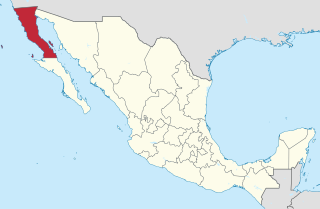
Baja California (Spanish pronunciation: [ˈbaxa kaliˈfoɾnja];, officially the Free and Sovereign State of Baja California, is a state in Mexico. It is the northernmost and westernmost of the 32 federal entities of Mexico. Before becoming a state in 1952, the area was known as the North Territory of Baja California. It has an area of 70,113 km2 and comprises the northern half of the Baja California Peninsula, north of the 28th parallel, plus oceanic Guadalupe Island. The mainland portion of the state is bordered on the west by the Pacific Ocean; on the east by Sonora, the U.S. state of Arizona, and the Gulf of California ; and on the south by Baja California Sur. Its northern limit is the U.S. state of California.

Baja California Sur, officially the Free and Sovereign State of Baja California Sur, is the second-smallest Mexican state by population and the 31st admitted state of the 32 states which make up the 32 Federal Entities of Mexico. It is also the ninth-largest Mexican state in terms of area.

The Sonoran Desert is a North American desert and ecoregion which covers large parts of the Southwestern United States in Arizona and California and of Northwestern Mexico in Sonora, Baja California, and Baja California Sur. It is the hottest desert in Mexico. It has an area of 260,000 square kilometers (100,000 sq mi). The western portion of the United States–Mexico border passes through the Sonoran Desert.
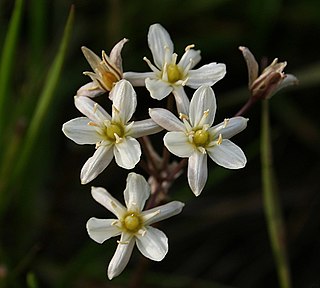
The genus Muilla includes three to four species of flowering plants.

Nolina is a genus of tropical xerophytic flowering plants, with the principal distribution being in Mexico and extending into the southern United States. They are large, dioecious plants.
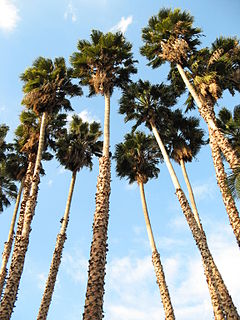
Washingtonia robusta, the Mexican fan palm or Mexican washingtonia, is a palm tree native to western Sonora and Baja California Sur in northwestern Mexico. It is reportedly naturalized in Florida, California, Hawaii, Texas, parts of the Canary Islands, Italy, Israel, Lebanon, Spain, and Réunion.

Tetracoccus is a plant genus under the family Picrodendraceae. Shrubby-spurge is a common name for plants in this genus.
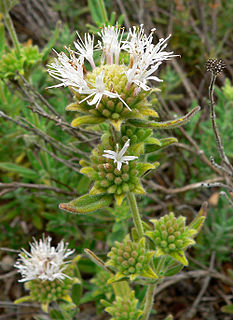
Monardella is a genus of approximately 40 species of annual and perennial plants native to western North America from British Columbia to northwestern Mexico. They are grown for their highly aromatic foliage, which in some species is used for herbal teas. The two-lipped, tubular flowers are formed in terminal clusters and are most usually red, pink, or purple.
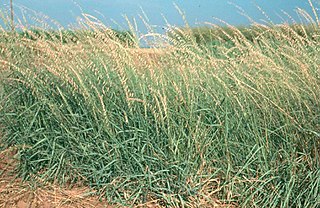
Bouteloua is a genus of plants in the grass family. Members of the genus are commonly known as grama grass.

Aridoamerica denotes an ecological region spanning Mexico and the Southwestern United States, defined by the presence of the culturally significant staple foodstuff Phaseolus acutifolius, a drought-resistant bean. Its dry, arid climate and geography stand in contrast to the verdant Mesoamerica of present-day central Mexico into Central America to the south and east, and the higher, milder "island" of Oasisamerica to the north. Aridoamerica overlaps with both.

Rafinesquia, commonly known as plumeseed, is a genus of flowering plants in the dandelion family, native to the western United States and northwestern Mexico.

Chaenactis is a genus of plants in the daisy family which are known generally as pincushions or dustymaidens.

Prunus fremontii is a North American species of plants in the rose family, known by the common name desert apricot. It takes its scientific name from John C. Frémont. It is found in northern and western Baja California especially, mostly Pacific and western, and the adjacent area of southern California. It also occurs in northern Baja California Sur.

The Lower Colorado River Valley (LCRV) is the river region of the lower Colorado River of the southwestern United States in North America that rises in the Rocky Mountains and has its outlet at the Colorado River Delta in the northern Gulf of California in northwestern Mexico, between the states of Baja California and Sonora. This north–south stretch of the Colorado River forms the border between the U.S. states of California/Arizona and Nevada/Arizona, and between the Mexican states of Baja California/Sonora.

Hibiscus denudatus is a perennial shrub of the mallow family, Malvaceae. It is in the rosemallow genus, Hibiscus.

Populus fremontii, commonly known as Frémont's cottonwood, is a cottonwood native to riparian zones of the Southwestern United States and northern through central Mexico. It is one of three species in Populus sect. Aigeiros. The tree was named after 19th century American explorer and pathfinder John C. Frémont.

Ambrosia salsola, commonly called cheesebush, winged ragweed, burrobush, white burrobrush, and desert pearl, is a species of perennial shrub in the sunflower family native to deserts of the southwestern United States and northwestern Mexico.

Mirabilis tenuiloba common names longlobe four o'clock or maravilla, is a plant species native to the south-western United States and north-eastern Mexico. It has been reported from Baja California, Baja California Sur, southern California and Arizona.

Ira Loren Wiggins was an American botanist, Curator of the Dudley Herbarium, and Director of the Natural History Museum (1940–1962) at Stanford University. He was a Stanford faculty member from 1929 until his retirement in 1964. He was the first recipient of the Fellow's Medal of the California Academy of Sciences. His Flora of Baja California is a standard work on the botany of the Baja peninsula and on the many islands of the Gulf of California.
References
- 1 2 3 Flann, C (ed) 2009+ Global Compositae Checklist Archived 2014-12-18 at Archive.today
- ↑ Watson, Sereno. 1889. Proceedings of the American Academy of Arts and Sciences 24: 54 in English
- ↑ Tropicos, Malperia S. Watson
- 1 2 "Malperia S. Watson". Flora of North America .
- 1 2 Jepson Manual Treatment
- ↑ Biota of North America Program 2013 county distribution map
- ↑ Turner, B. L. 1997. The Comps of Mexico: A systematic account of the family Asteraceae, vol. 1 – Eupatorieae. Phytologia Memoirs 11: i–iv, 1–272
- ↑ Calflora